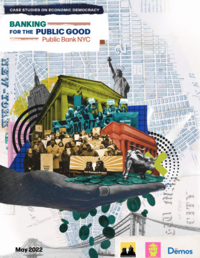The Great Recession of 2008— caused by decades of corporate consolidation, deregulation, and predatory mortgage lending— nearly brought down the global economy. In response, the United States government awarded $700 billion in bailout funds to commercial banks and other corporations deemed “too big to fail.” Yet it provided no structural assurance that the same crisis would not happen again.
New York City had a front row seat to the economic upheaval as home to the world’s largest stock exchange and preeminent investment banks. Black, brown, and immigrant New Yorkers felt the consequences of Wall Street’s actions. Research shows that there was a disproportionately high concentration of subprime mortgage lending in Black and Hispanic communities compared to white communities just prior to the Great Recession. These disparities contributed directly to higher foreclosure rates for Black and Hispanic homebuyers.
By 2010, a year after the recession’s official end, thousands of New Yorkers struggled to find affordable housing and found themselves on the verge of homelessness. Hundreds of luxury condominium units remained vacant; meanwhile, small businesses closed their metal roll-up doors and shut down for good. The city’s collective wealth was siphoned to the top 1 percent. As the Neighborhood Economic Development Advocacy Project (NEDAP) saw it, the government failed the people. It was clear to NEDAP, a NYC-based social justice organization, and other organizations at the forefront of efforts to challenge the unequal banking system in New York, that the recession was caused not only by predatory lending but also by underlying inequities in our financial system and economy, including problems of distribution and access to financial resources. As household-level recovery sputtered, the top commercial banks escaped liability for their role in the global economic crisis and used increased lobbying expenditures and political influence to grow bigger.
NEDAP’s view was popularized during Occupy Wall Street, which sprouted in New York City in 2011. After more than a decade of fighting predatory lending, NEDAP decided to return to its organizational roots, focusing their energies, coalition building, and policy work on affirmative and structural solutions. They reorganized their work and campaigns to pursue dual strategies of challenging systemic economic discrimination and working with neighborhood organizations to build new institutions—such as mutual housing, community land trusts, and community-owned financial cooperatives—rooted in economic democracy, racial justice, and community control. In 2013, NEDAP renamed itself New Economy Project with an explicit vision of restructuring the economy.
Establishing a public bank—a financial institution owned by a public entity, like a city or state government, that is accountable to the public—became a key strategy in pursuit of this new economic vision. New Economy Project began to convene groups around the idea of public banking in 2015, and in 2018 launched the Public Bank NYC (PBNYC) coalition.
The coalition gathered working-class Black, brown, and immigrant New Yorkers to arrive at a bold vision. They called for investing New York City’s municipal funds—including those generated through taxes and payments from state and federal government—in local community needs, including permanently affordable housing, community controlled financial institutions, small and worker-owned businesses, and community solar and other measures to address the climate crisis.
Now, in this third year of the pandemic, as the city seeks to rebound from repeated shutdowns, the goals of PBNYC seem even more necessary. The coalition is urging policymakers to learn from the past decade of one-sided economic recovery and choose instead to restore public control over public funds.
Download the Full PDF

